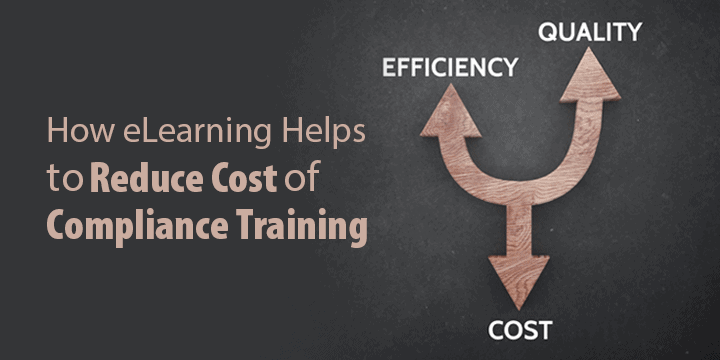Organizations across the globe are dealing with changes in regulatory norms, the uncertainty associated with it, the liabilities and the general dependency on compliance resources. Compliance training is a compulsory component of organizational functioning, very often one that cannot be overlooked. However, with the recent socio-economic developments in some countries, decreased budget etc. there have been second thoughts about the need of the compliance training and its reinforcement at a regular interval. Having said that like any other training compliance training does not come free and it definitely has cost associated to it. While we usually expect the cost to be equated with training time and resources, some organizations even map it in terms of labor cost, i.e. which is nothing but the hourly rate for every employee undergoing training. This cost in case of compliance training is often high. While the calculation of actual cost of compliance training is debatable, eLearning is often said to decrease the cost in general.
Some organizations hence opt for either just eLearning or a blended approach where both classroom training and eLearning is used for optimum benefits. Compliance training being an integral part of the business, needs to be continuous and reinforced. This in case of traditional training would involve scheduling issues, problems related to finding and booking the training area, allocation issues, the cost associated and the overall loss in production time. eLearning helps in reducing the cost associated with all of those and more. And How?
- Effective and Up-to-date Training
What does that have to do with cost effectiveness of compliance training?Compliance standards are updated constantly, and lack of adherence often means severe impact on the organization’s operations, followed by fines and other legal and statutory penalties. Web-based eLearning, just needs an update, and the content is modified for all the learners. Hence, eLearning assists in delivering up-to-date training, saving the cost otherwise associated with non-adherence to standards. - Preventive
Many a times, learning gaps in compliance training can lead to accidents within the organization. Safety rules and regulations are often covered in a rush and the non-reinforcement of such topics can cause severe damage to both infrastructure and economy. eLearning not only assists in covering holistic compliance training, but also comes in handy for on-the-job training, training reinforcement, workforce enablement, etc. Hence, preventing safety hazards and accidents at workplace. - Global Reach
While traditional compliance training requires gathering all the learners at one place, finding and hiring a trainer, keeping resources ready, travel and accommodation arrangements etc. all have associated costs. ELearning cuts this down multi-fold, by allowing faster and wider outreach without any travel and other hassles. - Accountability
Compliance is a serious responsibility in many organizations. Say for instance, Pharmaceutical companies that impact millions of lives. Compliance training prevents many mishaps. However, for tracking the learning, and verifying that employees have taken the necessary courses, usually a learning management system is required. With trackable eLearning actions are more accountable. As a result, overall functioning and productivity is impacted too.
Apart from these, eLearning also improves the overall efficiency of employees. Good compliance training reduces risks, streamlines the processes, increases transparency, makes employees more efficient and hence improves the output all in a cost-effective way. To conclude as an initial investment it may sound that investing in compliance training may be a cost, but imagine the peace of mind one can buy by investing in right compliance training. I hope this has given you the right perspective about the compliance eLearning and its cost effectiveness.



